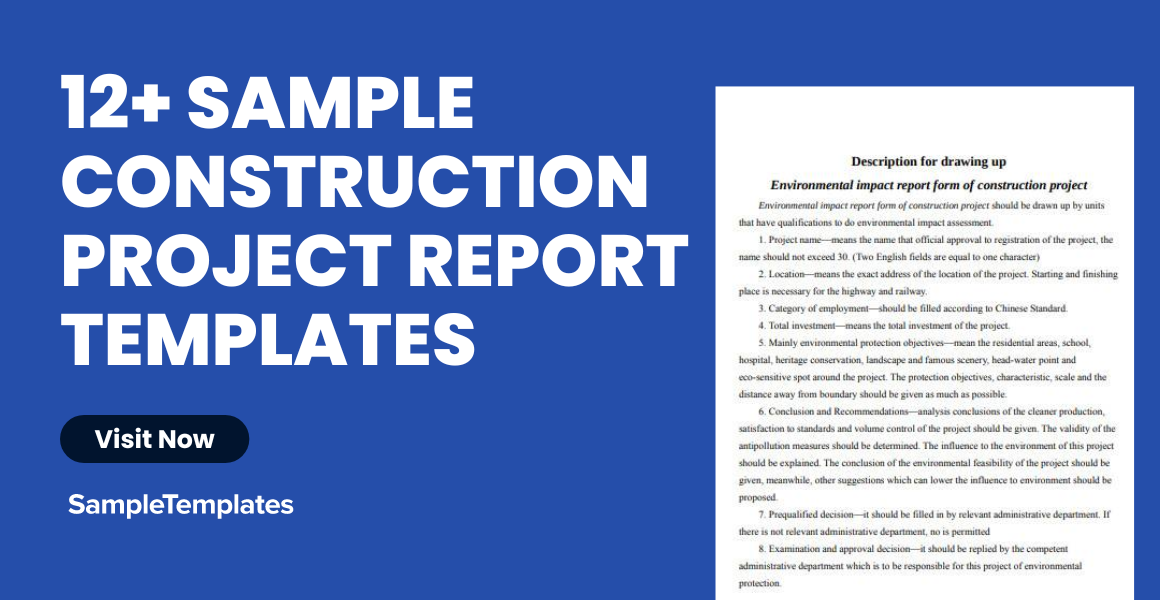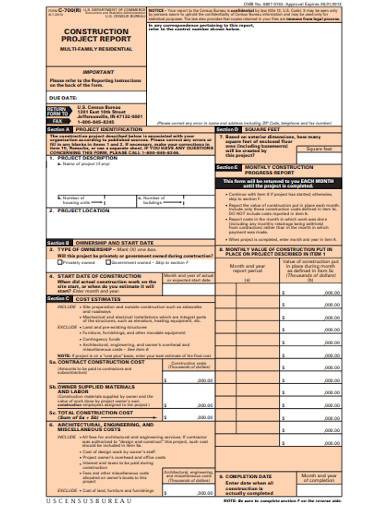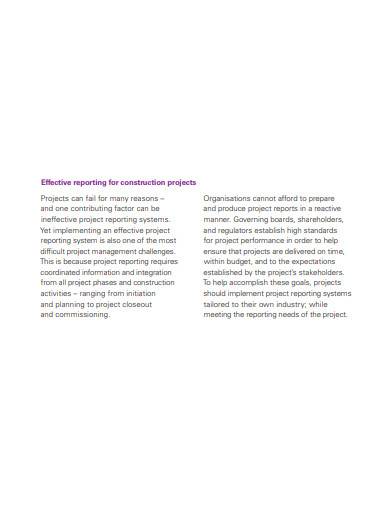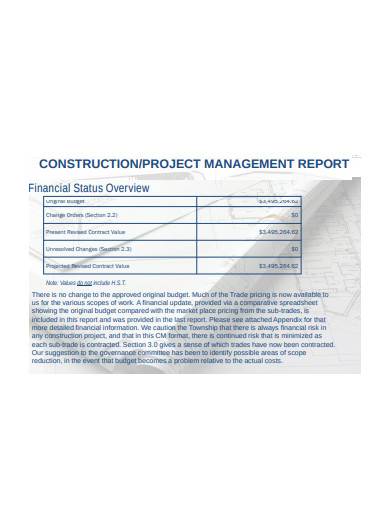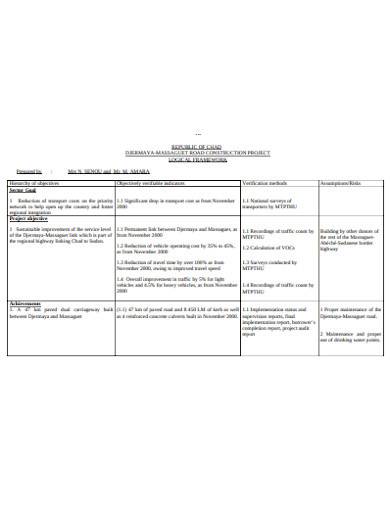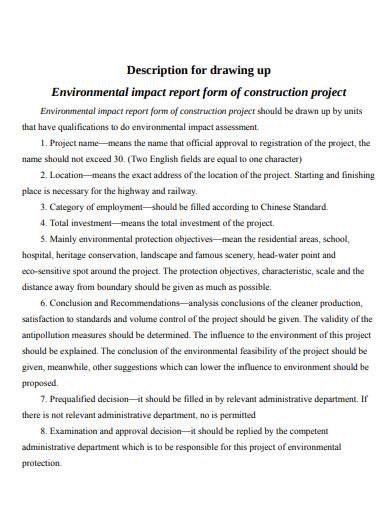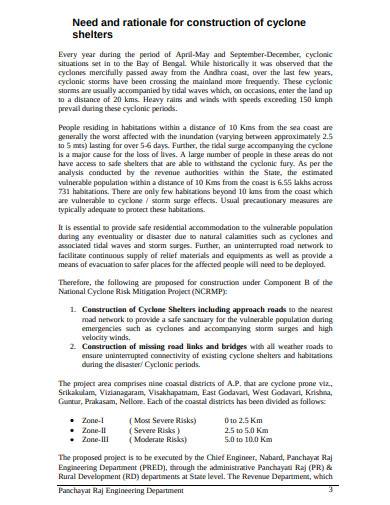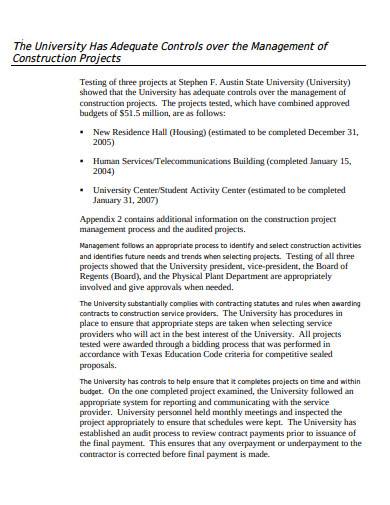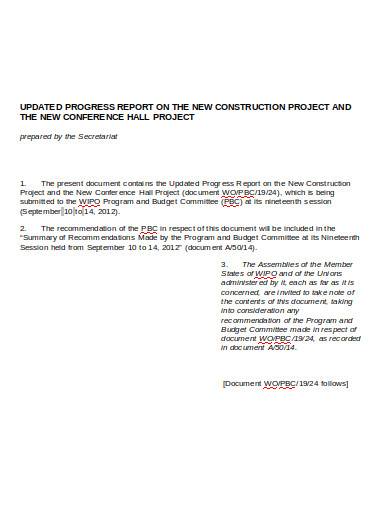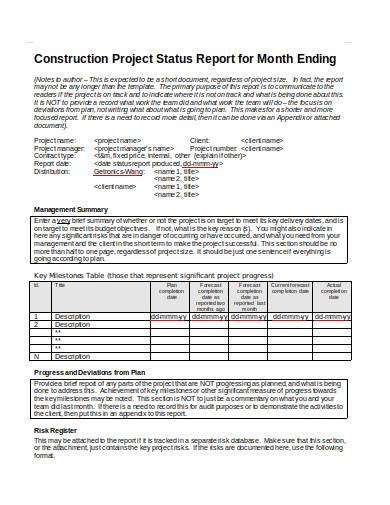The real test of a successful building plan isn’t in the project proposal but the tracking of its progress. When you keep yourself updated on the work analysis at the site, the completion eventually becomes less like a hopeful thought and more of a reality. As such, never leave your plan alone, thinking that it’ll “naturally grow” because if pitfalls do occur, you won’t notice them until it’s too late.
Building Construction Project Report Template
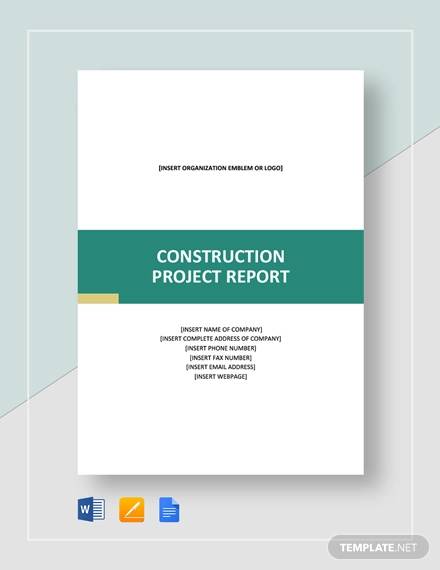
Construction Project Buyout Report Template
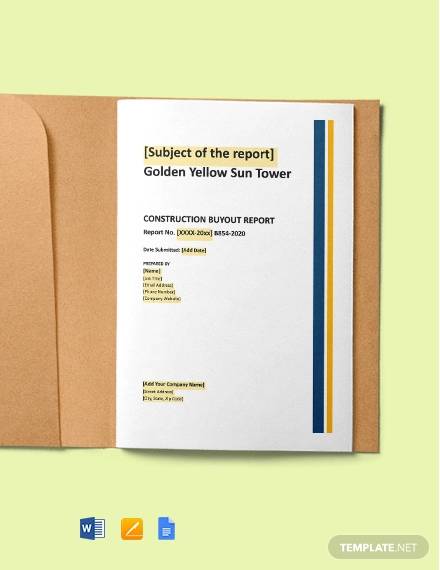
Construction Project Management Report Template
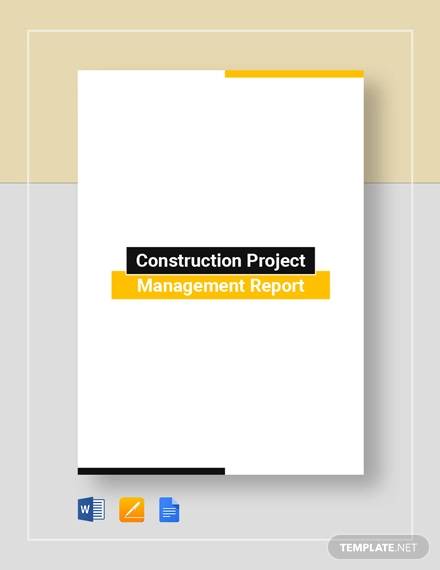
Construction Project Report Samples
Construction project reports are an effective means of acquiring and providing information and updates on the status of the building plan. As a matter of fact, they are vital to the entire endeavor reaching the completion date with nothing wrong whatsoever. This is because these documents help you keep tabs on your project from start to finish. From every process to every material used, knowing what goes on at the construction site provides you with plenty of information on how to solve problems, improve the system, and reach the deadline with flying colors.
1. Construction Project Report in PDF
Infrastructure is quite a finicky industry; one wrong move or investment could send you into a plummet of lawsuits and bankruptcy. However, this is easily avoidable through implementing safety protocols and work flowcharts to keep your crew focused on both safety and the project. One example of a document that does this effectively is this Construction Project Report. This template provides you with both a financial spreadsheet to task list your expenditures and multiple sections for other important details. Easy to use, free to download, and safe to store, this is the best template to use as a guide while you draft.
2. Reporting for Construction Projects Template
One of the things that both business analysis and infrastructure have in common is the need for productivity. Though not necessarily in the same way, both concepts require activities to be done on time and of the highest quality. As such, utilizing this Effective Reporting for Construction Projects helps you draft your document as it’s a high-quality template that’s free to use and easy to download. To top it all off, this template is also safe to use on your device and convenient to download—only a click of a button away.
3. Financial Status Construction Project Management Report
Using a sample construction report can assist you greatly by increasing your productivity without sacrificing your quality. However, the problem with this technique is the hassle of finding a reliable source that isn’t virus-ridden or hidden behind a paywall. With that in mind, if you’re looking for a construction project report sample, look no further than this Construction Project Management Report. This template is easy to use, free to download, safe to store on your device, so click the button now and prepare to experience convenience like never before.
4. Road Construction Project Completion Report
The details found in a road construction project report—especially if it’s a government-funded plan—should be scrutinized intensely to avoid any anomalies. More so highway problems than audit report issues, what you want in this type of construction project report format is a comprehensible layout of all essential details such as incidents or tar disruptions. You can follow this Road Construction Project Completion Report’s technique of arranging information into brackets to categorize data and ease your reader’s eyes by not bombarding them with text as long as the highway you just made.
5. Environmental Impact Report Form of Construction Project
The contribution that infrastructure has had on man’s carbon footprint is evident, and it continues to be so for as long as man does nothing about it. As such, new and more sustainable building techniques are being mobilized to preserve Mother Earth without compromising a human necessity. For instance, this Environmental Impact Report Form of Construction Project highlights “environmental protection objectives” as a goal list for the entire plan. Free to utilize, easy to download, and safe for your device—and advertently the environment too—there’s no reason not to make good use of this template today.
How do you write a construction project report?
Writing a Construction Project Report involves a systematic and detailed approach to document the various aspects of the project. Here’s a general guide on how to structure and write a construction project report:
- Title Page:
- Include the project title, your name, date, and any other relevant details.
- Executive Summary:
- Provide a brief overview of the project, summarizing key points such as objectives, scope of work, and major achievements.
- Table of Contents:
- List all the sections and subsections with page numbers for easy navigation.
- Introduction:
- Introduce the project, including its background, purpose, and objectives.
- Project Overview:
- Offer a detailed description of the project, including its scope, location, and timeline.
- Project Objectives:
- Clearly state the goals and objectives of the project.
- Project Scope:
- Define the boundaries and limitations of the project.
- Project Participants:
- List and describe the key stakeholders, project team members, and their roles.
- Project Timeline:
- Provide a visual representation or a detailed sample timeline of the project phases.
- Methodology:
- Explain the methods and processes used in the construction, including any specific technologies or approaches.
- Site Details:
- Describe the location, terrain, and any relevant site-specific details.
- Progress Summary:
- Present an overview of the project’s progress, highlighting major milestones and accomplishments.
- Challenges and Solutions:
- Discuss any challenges encountered during the construction and the strategies implemented to overcome them.
- Budget and Expenditures:
- Provide a breakdown of the budget, detailing costs, expenses, and any financial variances.
- Quality Control and Assurance:
- Explain the measures taken to ensure the quality of work and compliance with standards.
- Safety Measures:
- Outline the safety protocols and initiatives implemented on the construction site.
- Environmental Impact:
- Address any environmental considerations and the project’s impact on the surroundings.
- Recommendations:
- Offer suggestions for improvement or future considerations.
- Conclusion:
- Summarize the key findings and outcomes of the project.
- Appendix:
- Include supporting documents, additional data, or any supplementary information.
- References:
- Cite any sample references or sources used in the report.
6. Project Report For Construction Of Cyclone Shelters
From tropical depressions to major hurricanes, cyclones are a devastating threat for unprepared cities and towns. Hence, the ability to protect your citizens from this natural disaster should be a significant priority in areas prone to such strong winds. The use of this Preliminary Project Report For Construction Of Cyclone Shelters allows you to estimate times of travel from specific regions, provides illustrations of “danger zones” as referred to in the document, and gives you this data in an easy-to-understand and free-to-download PD file.
7. Medium Rise Construction Project Evaluation Report
Though evaluation reports are essential to quality control in today’s society, it’s even more critical to infrastructure. A small dent in the support beams or a crack in the foundation has led to entire buildings collapsing. As such, when planning to engineer a structure, using this Medium Rise Construction Project Evaluation Report proves helpful to your plan’s completion. This template is easy to use, free to download, and safe to utilize on any device, so what are you waiting for? Download this template now for and enjoy these convenient services for only $0.00.
8. Controls over Construction Project Management Template
With all the needed resources, workforce, and equipment, it is evident that a construction project requires a massive budget. However, with such significant funds come equally hefty problems such as improper spending or building money bulking up wallets instead of support beams. Hence, track your expenditures with this Audit Report on Controls over Construction Project Management to ensure that funds go where they should. Not only is this template free to use and easy to download, but it’s also safe to store on your device for convenience without worry. So what are you waiting for? Click the button now and enjoy the services that this template offers you.
9. Progress Report On The New Construction Project Template
A progress report is used in construction to inform VIPs of everything occurring on the site. Essential details such as finished work, what’s still in progress, and challenges that transpired are recorded and summarized before being submitted to any one of the higher-echelon. This Updated Progress Report On The New Construction Project Sample is a template you can use if you want continuous updates on the status of your plan. Furthermore, this sample is easy to use, free to download, and provides you with a safe PDF file you can conveniently use as a guide in drafting.
How do I report progress on a construction project?
Reporting progress on a construction project is essential for effective communication and project management. Here’s a guide on how to report progress on a construction project:
- Define Reporting Periods:
- Establish regular reporting periods (weekly, bi-weekly, monthly) to provide consistent updates.
- Key Performance Indicators (KPIs):
- Identify and track key performance indicators relevant to construction projects, such as completion percentages, timelines, budget adherence, and safety records.
- Project Dashboard:
- Create a visual dashboard that presents critical information at a glance. Include sample charts, graphs, and tables to illustrate progress.
- Written Progress Reports:
- Prepare written reports detailing project progress. Include the following sections:
- Introduction:
- Briefly describe the purpose and scope of the report.
- Accomplishments:
- Highlight completed tasks and achievements since the last report.
- Work in Progress:
- Detail ongoing activities and their current status.
- Upcoming Tasks:
- Outline tasks planned for the next reporting period.
- Challenges and Solutions:
- Identify any issues or challenges encountered and the corresponding solutions.
- Budget and Cost Update:
- Provide an overview of the budget status and any changes.
- Safety and Quality:
- Report on safety measures and the quality of work.
- Recommendations:
- Offer suggestions for improvement or changes in strategy.
- Conclusion:
- Summarize the overall project progress.
- Introduction:
- Prepare written reports detailing project progress. Include the following sections:
- Photographic Evidence:
- Include photographs or visual documentation process of the construction site to support your written progress report. This can provide a clear understanding of the work completed.
- Timeline Updates:
- Review and update the project timeline to reflect any changes or adjustments.
- Communication with Stakeholders:
- Regularly communicate with stakeholders, including project owners, investors, and team members. Keep them informed about progress, challenges, and future plans.
- Meetings and Presentations:
- Schedule regular progress meetings or presentations where team members can discuss updates, ask questions, and provide input.
- Document Control:
- Ensure proper document control, including versioning of plans, drawings, and other relevant documents. Keep all stakeholders on the same page with the latest information.
- Feedback Mechanism:
- Establish a sample feedback mechanism for team members to report challenges or suggest improvements. Encourage open communication.
- Continuous Improvement:
- Use progress reports as a tool for continuous improvement. Analyze trends, identify areas for enhancement, and implement changes as needed.
10. Month Ending Construction Project Status Report Template
A solid template in its own right, this sample Construction Project Status Report for Month Ending provides you with an easy-to-use and free-to-download PDF file. This document is also safe to store on your device and gives you the quality and convenience you’re looking for. So what are you waiting for? Click the button right now and start writing today!
What is the last stage of project report?
The last stage of a project report is the conclusion, summarizing key findings, discussing implications, and providing sample recommendations for future actions, ensuring a comprehensive understanding of the project’s outcomes.
Why is construction report important?
A construction report is crucial as it tracks project progress, identifies challenges, and ensures effective communication among stakeholders, contributing to informed decision-making and successful project completion.
What is the frequency of project reporting?
Project reporting frequency depends on project size and complexity. Typically, it ranges from weekly to monthly, ensuring timely updates, effective communication, and swift issue resolution for successful project management.
Related Posts
Sample Technical Reports
Sample Security Incident Reports
Trip Report Samples & Templates
Sample Book Report Templates
Sample Chemistry Lab Reports
School Accomplishment Report Samples & Templates
Field Report Samples & Templates
Sample Science Project Reports
Business Report Samples & Templates
Survey Reports Samples & Templates
Sample Feasibility Reports
Psychological Assessment Report Samples [ Clinical, Child, Intake ]
Report Format Samples & Templates
Acknowledgement for Internship Report Samples [ Hotel, Hospital, Teaching ]
Field Trip Report Samples [ Agriculture, Educational, Environmental ]
